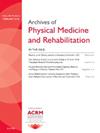脊髓损伤患者自我报告处方氢可酮、羟考酮和曲马多的使用情况与意外伤害之间的关系。
IF 3.6
2区 医学
Q1 REHABILITATION
Archives of physical medicine and rehabilitation
Pub Date : 2024-10-01
DOI:10.1016/j.apmr.2024.05.013
引用次数: 0
摘要
目的确定三种常用处方阿片类药物(氢可酮、羟考酮和曲马多)与意外伤害的关系,包括慢性创伤性脊髓损伤(SCI)成人中与跌倒相关和非跌倒相关的伤害:设计:横断面队列研究:环境:美国东南部的社区环境:从专科医院和州人口登记处确定患有慢性外伤性脊髓损伤的成人参与者(N = 918),并完成自我报告评估:不适用:干预措施:不适用。主要结果测量:自我报告的在过去 12 个月内与跌倒相关和非跌倒相关的意外伤害,伤害严重程度足以在诊所、急诊室或医院接受医疗护理:略高于 20% 的参与者报告在过去一年中发生过一次或多次意外伤害,其中至少发生过一次意外伤害的参与者平均受伤次数为 2.16 次。总体而言,9.6%的人报告了与跌倒有关的伤害。只有氢可酮与过去一年的意外伤害有关。偶尔(每月不超过一次)或经常(每周或每天)服用氢可酮与过去一年中至少发生一次意外伤害的几率分别增加 2.63(95% CI =1.52,4.56)或 2.03(95% CI =1.15,3.60)有关。偶尔服用氢可酮也与过去一年非跌倒相关伤害有关(OR =2.20;95% CI =1.12,4.31)。这三种阿片类药物中的每一种都与跌倒相关伤害有显著关系。偶尔服用氢可酮导致跌倒相关伤害的几率增加 2.39 倍,偶尔服用氢可酮导致跌倒相关伤害的几率增加 2.31 倍。经常使用羟考酮与发生跌倒相关伤害的 2.44 倍几率相关(95% CI = 1.20,4.98),经常使用曲马多与发生跌倒相关伤害的 2.59 倍几率相关(95% CI = 1.13,5.90):预防伤害的工作必须考虑使用阿片类药物,尤其是氢可酮的潜在影响。要预防与跌倒有关的伤害,必须考虑到三种阿片类药物中的每一种。本文章由计算机程序翻译,如有差异,请以英文原文为准。
Relations Between Self-reported Prescription Hydrocodone, Oxycodone, and Tramadol Use and Unintentional Injuries Among Those With Spinal Cord Injury
Objective
To identify the relations of 3 frequently used prescription opioids (hydrocodone, oxycodone, tramadol) with unintentional injuries, including fall-related and non–fall-related injuries among adults with chronic, traumatic spinal cord injury (SCI).
Design
Cross-sectional cohort study.
Setting
Community setting; Southeastern United States.
Participants
Adult participants (N=918) with chronic traumatic SCI were identified from a specialty hospital and state population-based registry and completed a self-report assessment.
Interventions
Not applicable.
Main Outcome Measures
Self-reported fall-related and non–fall-related unintentional injuries serious enough to receive medical care in a clinic, emergency room, or hospital within the previous 12 months.
Results
Just over 20% of participants reported ≥1 unintentional injury in the past year, with an average of 2.16 among those with ≥1. Overall, 9.6% reported fall-related injuries. Only hydrocodone was associated with any past-year unintentional injuries. Hydrocodone taken occasionally (no more than monthly) or regularly (weekly or daily) was related to 2.63 (95% confidence interval [CI], 1.52-4.56) or 2.03 (95% CI, 1.15-3.60) greater odds of having ≥1 unintentional injury in the past year, respectively. Hydrocodone taken occasionally was also associated with past-year non–fall-related injuries (OR, 2.20; 95% CI, 1.12-4.31). Each of the 3 opioids was significantly related to fall-related injuries. Taking hydrocodone occasionally was associated with 2.39 greater odds of fall-related injuries, and regular use was associated with 2.31 greater odds. Regular use of oxycodone was associated with 2.44 odds of a fall-related injury (95% CI, 1.20-4.98), and regular use of tramadol was associated with 2.59 greater odds of fall-related injury (95% CI, 1.13-5.90).
Conclusions
Injury prevention efforts must consider the potential effect of opioid use, particularly hydrocodone. For preventing fall-related injuries, each of the 3 opioids must be considered.
求助全文
通过发布文献求助,成功后即可免费获取论文全文。
去求助
来源期刊
CiteScore
6.20
自引率
4.70%
发文量
495
审稿时长
38 days
期刊介绍:
The Archives of Physical Medicine and Rehabilitation publishes original, peer-reviewed research and clinical reports on important trends and developments in physical medicine and rehabilitation and related fields. This international journal brings researchers and clinicians authoritative information on the therapeutic utilization of physical, behavioral and pharmaceutical agents in providing comprehensive care for individuals with chronic illness and disabilities.
Archives began publication in 1920, publishes monthly, and is the official journal of the American Congress of Rehabilitation Medicine. Its papers are cited more often than any other rehabilitation journal.

 求助内容:
求助内容: 应助结果提醒方式:
应助结果提醒方式:


